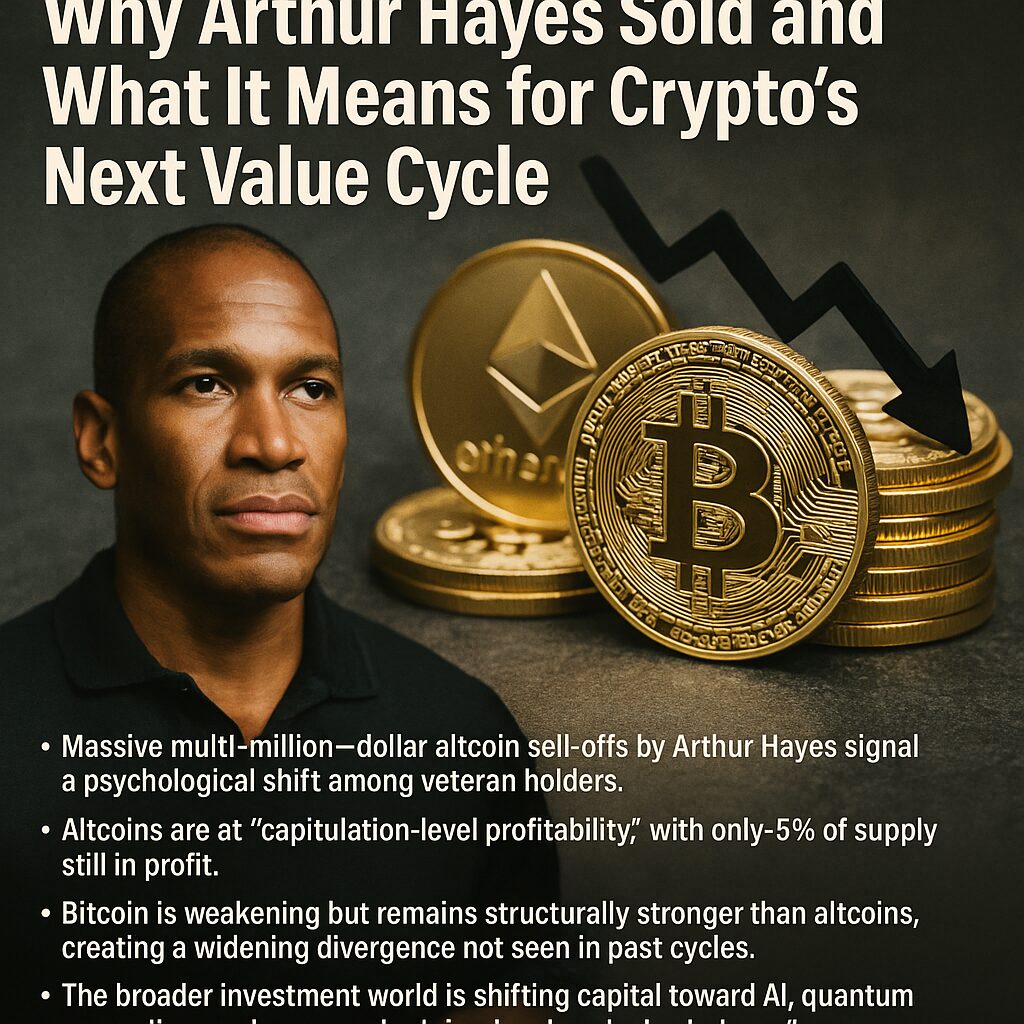
Main Points :
- Massive multi-million-dollar altcoin sell-offs by Arthur Hayes signal a psychological shift among veteran holders.
- Altcoins are at “capitulation-level profitability,” with only ~5% of supply still in profit.
- Bitcoin is weakening but remains structurally stronger than altcoins, creating a widening divergence not seen in past cycles.
- The broader investment world is shifting capital toward AI, quantum computing, and data-center infrastructure instead of crypto.
- Analysts argue the classic “4-year cycle” is outdated—real-world value and utility must drive the next wave.
- Short-term macro triggers (U.S. layoff numbers, tech-stock correction) are adding extra downward pressure.
- For builders and investors, this is the phase where real utility projects can quietly gain ground before capital returns.
1. Introduction — A Turning Point Hidden in the Noise
In the middle of a turbulent month for crypto markets, one event stood out: Arthur Hayes, BitMEX founder and one of the most influential voices in digital assets, appeared to have sold millions of dollars’ worth of altcoins—even though he recently signaled long-term optimism. Markets reacted with intense speculation: Why now? What changed? And what does this mean for the next wave of crypto value creation?
This article analyzes Hayes’s sell-off, on-chain trends, the weakening profitability across the altcoin market, and the emerging macroeconomic backdrop. We also extend the discussion using recent external trends in AI, monetary policy, and investment flows to understand the bigger picture.
2. Arthur Hayes’ Massive Altcoin Liquidation
On November 16, Lookonchain reported a series of significant token disposals by Arthur Hayes. His transactions included:
- $820,000 in ETH
- $651,000 in ENA
- $480,000 in LDO
- $289,000 in AAVE
- $201,000 in UNI
Just hours earlier, he had also sold:
- $1.6 million in ETH
- $733,000 in ENA
- $124,000 in ETHFI
Combined, Hayes sold roughly $5 million ($8 million) worth of tokens in two waves—far from a casual rebalancing.
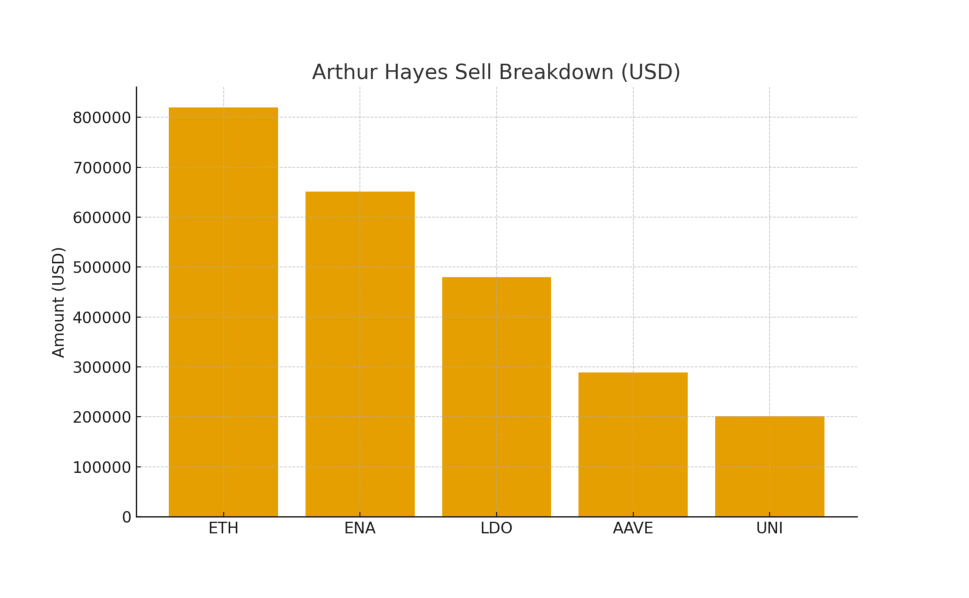
This surprised many traders because Hayes had previously signaled strong confidence in holding these assets long-term. His sudden reversal suggests that even market veterans are losing conviction in near-term altcoin strength.
3. Ethereum Veteran Investors Are Also Selling
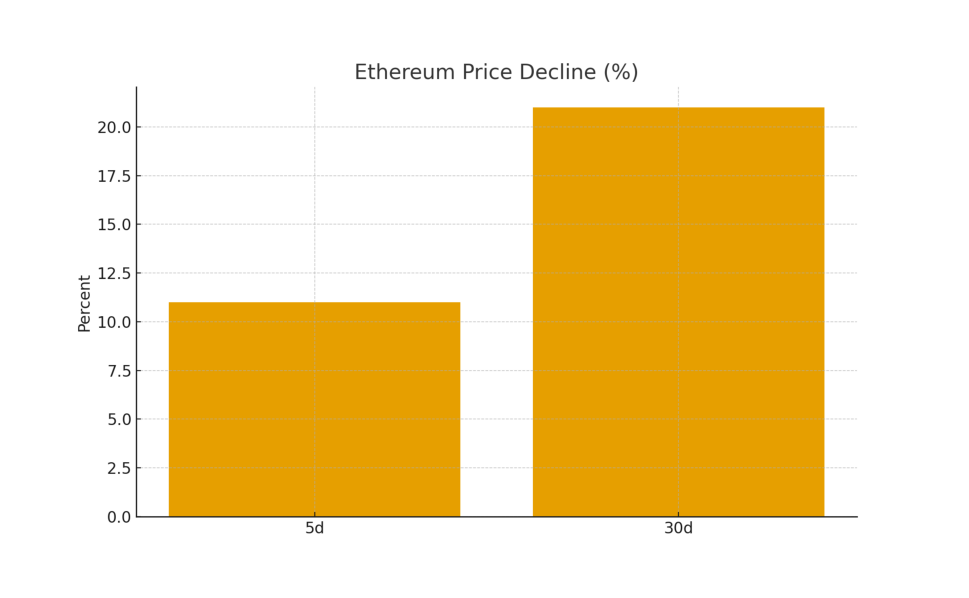
On November 14, on-chain analytics firm Glassnode noted that Ethereum’s “veteran investor” cohort (long-term holders) was selling at the fastest pace since February 2021.
Ethereum’s price performance reflects this sentiment:
- −11% over the last 5 days
- −21% over the last 30 days
This contrasts sharply with Bitcoin, which is weakening but not collapsing.
📌 Insert Chart Here — Ethereum Price Decline
File: eth_decline.png
4. Altcoins Are in a “Full Capitulation” Zone
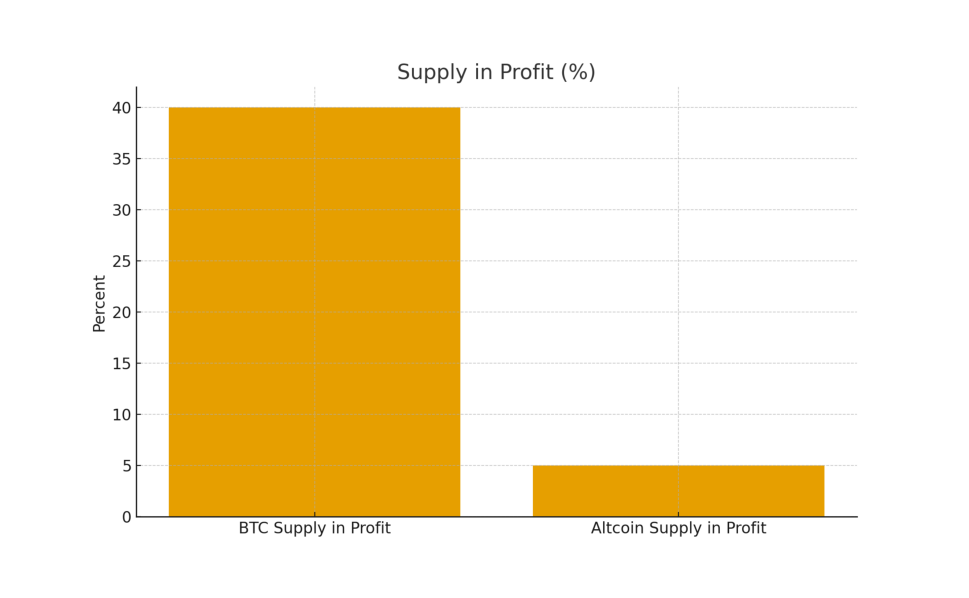
Glassnode also compared the percentage of token supply currently in profit:
- Altcoins: ~5% of supply in profit
- Bitcoin: Significantly higher (rough illustrative comparison in chart)
This indicates that altcoins have reached the same “forced seller” region that appeared at major historical bottoms—though this time under different macro conditions.
📌 Insert Chart Here — Supply in Profit (BTC vs Altcoins)
File: supply_profit.png
However, Glassnode warns:
“The divergence between Bitcoin and altcoins has no historical precedent.”
This suggests the market is not simply repeating previous cycles. Something deeper is shifting.
5. Why the Divergence? Crypto Is Losing Attention to AI and the ‘Magnificent Seven’
Castle Island Ventures partner Nic Carter offered a broader explanation:
“Crypto is now the forgotten child. AI and the Magnificent Seven are the main characters.”
The “Magnificent Seven” refers to:
- Apple
- Microsoft
- Amazon
- Meta
- NVIDIA
- Tesla
These companies dominate global capital flows and business narratives. Investors are now focusing on:
- Data centers
- AI compute infrastructure
- Quantum computing
- Rare-earth supply chains
Compared to these sectors, crypto is not drawing the same level of speculative or institutional attention.
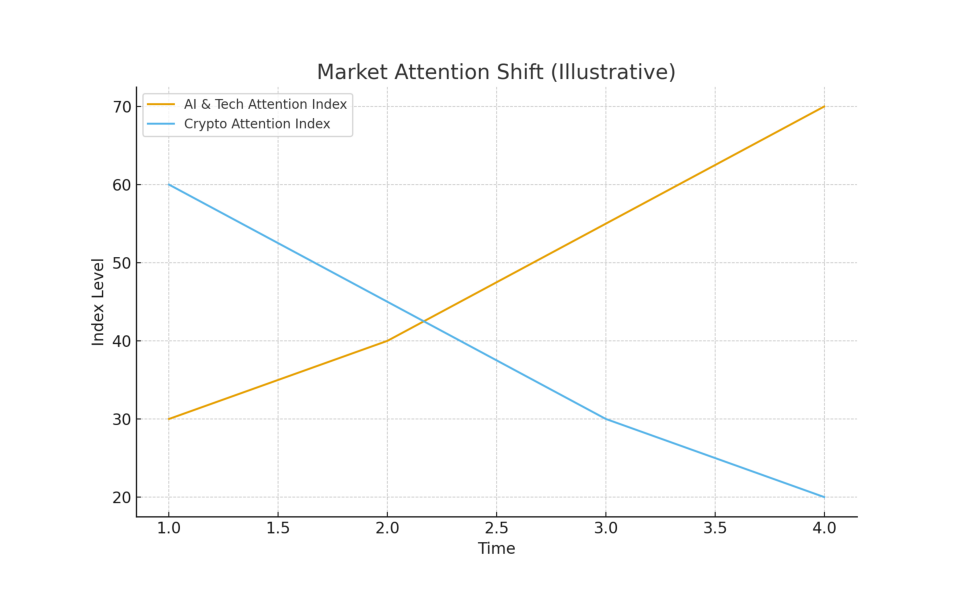
Carter argues this is not due to scandals like FTX, but instead:
- Market exhaustion
- Declining attention
- Fewer new buyers
- Prolonged treasury-fund selling
This context explains why even high-quality altcoins cannot attract strong upward pressure.
6. The Death of the “4-Year Cycle”? Value Must Replace Storytelling
Carter goes further, stating the classic “4-year cycle” anchored around Bitcoin halving events no longer reflects market dynamics.
Why?
- Institutional adoption has changed market structure
- AI & big tech compete for speculative capital
- Retail attention has diversified
- Liquidity cycles move independently of halving schedules
Most importantly:
“Crypto must prove real-world value to win the next cycle.”
This aligns with the emerging philosophy shared by investors in 2025:
- Utility > Hype
- User adoption > tokenomics
- Ecosystem design > speculative cycles
This is particularly relevant for teams building wallets, payments, and real-world blockchain systems—exactly the audience of this article.
7. Short-Term Macro: Why Markets Are Risk-Off Right Now
The market is citing two short-term factors :
1. U.S. Layoff Numbers Fell Below Expectations
Paradoxically, this increased recession fears, because it suggests companies may be reducing costs in a longer, slower cycle rather than a sudden one.
This creates a risk-off environment—bad for crypto.
2. Weakness in U.S. Tech Stocks Pulled Bitcoin Down
Even though Bitcoin has recently weakened its correlation with Nasdaq, investor behavior still connects them:
- When tech stocks sell off
- Bitcoin faces selling pressure
- Altcoins fall even harder
Hasegawa also pointed out that Bitcoin has now entered a “oversold region,” suggesting it may be near a local bottom—even if altcoins are not.
8. The Bigger Picture: Liquidity Is Moving Into Hard Assets and Real Yield
Outside crypto, global capital flows are increasingly moving into:
- U.S. Treasury yields (5–10-year)
- AI infrastructure (NVIDIA-led hardware)
- Data centers and cloud providers
- Commodity plays (rare earths, lithium, copper)
Crypto, being high-beta and lacking immediate yield, loses attention during such rotations.
9. What This Means for Builders and Investors
For readers interested in new crypto assets, yield opportunities, and practical blockchain applications, here is what the current environment implies:
1. This Is the Phase Where Fundamentals Finally Matter
Projects solving real payment, settlement, custody, compliance, and infrastructure problems have the strongest chance of gaining market share.
2. Tokens Without Revenue or Utility Will Not Recover Easily
A large percentage of altcoins may never return to ATH levels or even to 50% retracement levels.
3. Builders Should Prioritize “Value Delivery,” Not Speculation
This includes:
- Cross-chain real settlement
- Stablecoin flows
- Non-custodial wallet UX
- Enterprise-grade compliance layers
- User identity + crypto rails
- Real-world revenue models
The next winners are more likely to be infrastructure rather than memecoins.
4. Investors Should Consider: Capitulation = Opportunity
Historically, when altcoins hit sub-10% profitability:
- Long-term accumulators begin building positions
- Strong projects quietly rally before major narratives return
- Liquidity cycles eventually rotate back into crypto after AI mania stabilizes
But selection matters more than ever.
10. Conclusion — A Cleansing Phase Before the Next Value Cycle
Arthur Hayes’ multi-million-dollar liquidation is not just a portfolio rebalance. It is symbolic of a broader shift: even strong believers are preparing for a long consolidation period.
Altcoins are reaching deep capitulation levels. Ethereum whales are selling at multi-year highs. Attention is drifting toward AI, big tech, and real-world infrastructure.
But this does not signal the end of crypto.
Instead, it marks the beginning of the value cycle—a phase where true utility, real-world impact, and sustainable economics will determine which projects become the next winners.
For entrepreneurs, builders, and strategic investors, this is the perfect moment to create and position products that solve real problems. When liquidity eventually returns—as it always does—the market will reward projects that deliver measurable value, not hype.

